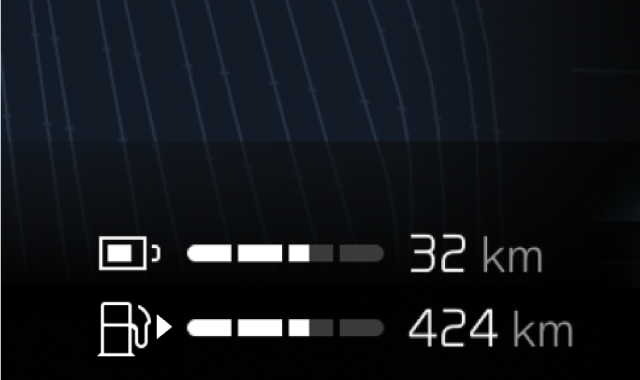
Your range is primarily related to your vehicle's battery, the amount of fuel left in the tank, and your driving practices, but external conditions can also be a factor. The battery level and expected range are displayed in the instrument panel. The expected range is calculated based on your driving pattern, both current and historical.
The displayed range is separated into how far you can drive with your current state of charge, as well as with your current fuel level. Depending on your driving style and your selected drive mode, your vehicle prioritizes using either the electric motor or the engine. The displayed range is an estimation and may differ accordingly.
Factors that affect your vehicle's range
How you drive your vehicle, which settings or features are active, weather conditions and traffic can all affect your vehicle's range in different ways.
| Speed | Driving at higher speeds drains the battery more and increases your fuel consumption. |
| Drive mode | Depending on your selected drive mode, your vehicle prioritizes the electric motor and the engine differently. |
| City driving and traffic situation | Varying your speed by frequently accelerating and braking will increase battery and fuel consumption compared to keeping a constant speed. |
| Outside temperature | The outside temperature can affect your battery consumption and range. |
| Battery temperature | A cold battery is less efficient and needs more energy to be heated. |
| preconditioning | By preconditioning your vehicle, you can decrease the energy used to heat up both the vehicle and the battery. This can be done in the climate settings. |
| Climate settings | Which climate features are active and how much they affect your battery and fuel consumption. |
| Tires and tire pressure | Tire condition and tire pressure can affect your range. |
| Road condition and topography | Road conditions and hilliness can affect your range. |
| Towing | Towing a trailer demands more power from your vehicle and will adversely affect battery and fuel consumption. This is relative to the type of trailer being towed. |
Range in cold temperatures
Cold temperatures can negatively affect your vehicle's battery. When the vehicle has a cold battery, a snowflake  appears next to the battery range. This indicates that the battery’s charge capacity and range are reduced compared to normal conditions. You can avoid this by always charging your vehicle while it's parked, which can prove especially useful if you are parking in a cold climate.
appears next to the battery range. This indicates that the battery’s charge capacity and range are reduced compared to normal conditions. You can avoid this by always charging your vehicle while it's parked, which can prove especially useful if you are parking in a cold climate.
When the battery warms up – for example, while preconditioning the vehicle or when driving – the snowflake disappears from the instrument panel.
Factory reset and range value
After a factory reset or when the vehicle is delivered from the factory, the estimated range is based on a certified value. After driving your vehicle for a while, the estimated range is instead based on your historical driving patterns.